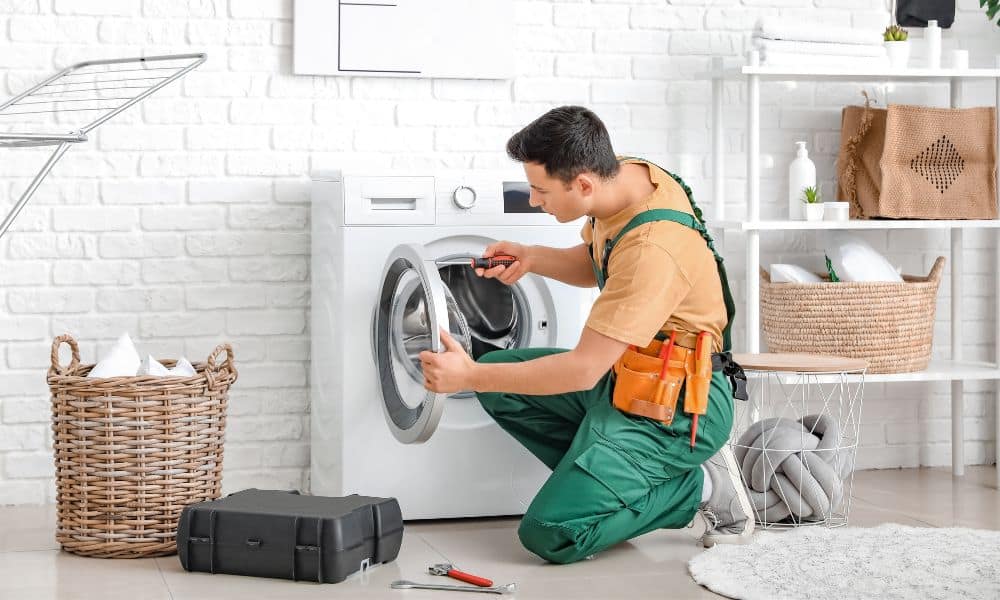Common Issues During Washing Machine Installation and How to Avoid Them

Setting up a washing machine might sound easy, but if you mess it up, you could end up with leaks, electrical issues, and a machine that doesn’t work right.
So, it’s a smart idea to know what you’re doing before you dive in. Being aware of possible problems can save you time and money.
We’re here to share some handy tips to make the whole process smoother, so your washing machine works perfectly from the start. With a good plan, you can keep troubles at bay and have a smooth, stress-free installation.
Choose the Right Location
Choosing where to put your washing machine is super important if you want it to last and work well. Make sure it’s on a stable and flat spot so it doesn’t shake or move around, which could mess things up.
Proximity to Utilities
It’s a good idea to place your washer near water and plug sockets. This makes hooking it up easy, and you won’t have hoses and cords all over the place. If space is tight, right-angled connectors can keep things tidy.
Space for Ventilation and Access
Leave a little gap, like 1 to 2 inches, around the machine. This helps it stay cool and stops it from overheating. Plus, it makes cleaning and fixing stuff easier, saving you time and hassle later. Planning this out now can make life way easier down the road.
Check Water Supply and Drainage
To keep your washing machine running smoothly, start by checking the water supply and drainage.
Look at the water hoses to see if there are any cracks or leaks, ’cause fixing these right away can stop water waste and flooding. Make sure the drainage hose is in the right spot, a bit raised, to stop any backflow.
Also, think about the water pressure; it should match what’s in your machine’s manual. Too much pressure might cause leaks, and too little might mean your machine doesn’t fill up right.
You can get a water pressure gauge at a hardware store to check this. If you’re ever unsure, asking a plumber for help is a good move. Doing these simple checks can keep your machine working well for longer, saving you time and cash in the long run.
Inspect Electrical Connections
Ensuring your washing machine’s plugged in right is super important for it to work well and last long.
First, check that the plug socket’s got three holes. This means it’s grounded, which stops electric shocks. Your machine’s plug should match the socket, usually a three-pin plug, to avoid problems.
Avoid Using Extension Cords
Don’t use extension cords because they might not handle your washing machine’s power needs and could overheat or cause a circuit trip. It’s best to plug it straight into the wall. If the cord is too short, maybe get an electrician to sort it out for good.
Safe Distance from Water
Make sure the plug socket’s not too close to water to avoid electric shocks and other issues. Keeping it about a foot away from water is a smart move. If you’re unsure, having an electrician check it out can help keep things safe.
Level the Washing Machine
To keep your washing machine running smoothly and quietly, make sure it’s level. Just pop a spirit level on top, checking from side to side and front to back. Adjust the feet at the bottom by twisting them until the bubble’s right in the middle.
It’s smart to check a few different ways to be sure. Once it’s level, tighten the nuts on the feet to keep them in place during washes. If it’s uneven, your machine might shake, make a racket, or even get damaged inside.
Levelling it helps it work better and last longer, so you won’t have to fork out for repairs. It’s like tuning a guitar—when it’s spot on, it works like a charm, cutting down on annoying breakdowns.
Secure Hoses Properly
Ensuring your washing machine hoses are snugly attached is crucial for keeping it leak-free and running smoothly. Think of it like fastening your seatbelt before a drive; it’s a small step that makes a big difference.
Loose hoses can lead to water sneaking out where it shouldn’t, potentially causing a puddle dance on your laundry room floor. So, take a moment to check those connections. A simple twist to tighten them can save you from a watery headache.
Position the Drainage Hose Correctly
When setting up your drainage hose, imagine you’re guiding a stream of water through a garden hose.
If you’ve ever tried to drink a milkshake with a straw that’s bent, you’ll know how frustrating blockages can be. It’s the same with your washing machine hose. Keep it relaxed and free from sharp bends so water can flow freely.
Aim for a gentle curve and ensure the end of the hose is higher than the machine’s water level. This little trick helps gravity do its job, preventing any unwanted spills or overflows.
Use Hose Clamps for Extra Security
Hose clamps are like the belt and braces of the washing machine world. They’re easy to use and add that extra layer of security against leaks. Pop one on with a screwdriver, and you’ll feel a bit like a DIY pro.
Make it a habit to give your hoses a once-over every now and then. Look for any signs of wear or cracks, and consider swapping them out every five years or so. It’s a small effort, but it keeps everything running smoothly and your machine in top shape.]
Once you’ve got everything snug and secure, you can sit back and relax, knowing your washing machine is in tip-top condition. Why not give your hoses a quick check today? Your future self—and your floors—will thank you!
Test the Machine After Installation
Once your washing machine’s all set up, you gotta make sure it works right. Start with a short cycle without any clothes in there, just to see how it runs.
This helps spot leaks and check if the drum spins smoothly. Keep an ear out for weird noises or shakes—they might mean something’s not right with the setup.
Inspect Water Connections and Drainage
Take a good look at the water connections for any drips. Sometimes, a quick tighten can sort out small leaks. Make sure the water flows out smoothly. If it’s draining slowly or looks blocked, check if the hose is twisted or clogged and fix it up.
Address Problems Promptly
Sorting out issues quickly can stop big water messes and expensive repairs later. If something feels off, it’s smart to tackle it right away.
For bigger problems, you might wanna call in a pro. Fixing things early keeps your washing machine running smoothly and saves you headaches down the road.
Conclusion
Fixing common setup issues will have your washing machine running smoothly. Ensure it’s level and the hoses are tightly secured.
Check that the water and electricity connections are safe. This prevents annoying noises, leaks, and potential damage.
With these steps, you’ll use your washing machine confidently. A good setup saves time and money while extending the machine’s life. So, get started and enjoy a perfectly working washing machine at home!

Source: Common Issues During Washing Machine Installation and How to Avoid Them




